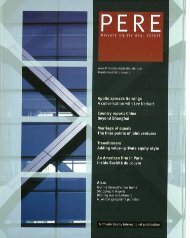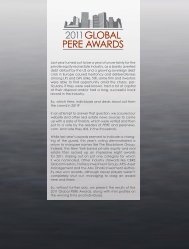2010AWARDS & AnnuAL REVIEW - PERE
2010AWARDS & AnnuAL REVIEW - PERE
2010AWARDS & AnnuAL REVIEW - PERE
Create successful ePaper yourself
Turn your PDF publications into a flip-book with our unique Google optimized e-Paper software.
Taking all this into consideration, cash compensation will remain<br />
relatively flat in the industry, Herzberg said, but a larger<br />
bonus pool will create the sense that compensation is on its way<br />
back up.<br />
the great regulatory hurdle<br />
On the regulatory front, 2010 saw an unprecedented level of<br />
initiatives begin to take shape as governments around the globe<br />
sought to reduce risks in the financial system. In Europe, the<br />
Alternative Investment Fund Managers (AIFM)<br />
directive and the Solvency II legislation are likely<br />
to have Europe-wide implications for all asset<br />
classes, including property. Meanwhile, in the US,<br />
the Dodd-Frank Act and the Volcker Rule are expected<br />
to have a similar impact.<br />
Gordon sees private equity real estate facing “a<br />
1-2-3 punch.” The first is broad financial regulation,<br />
including the Dodd-Frank Act in the US and<br />
European Market Infrastructure Regulation in<br />
Europe. The second is insurance regulation, specifically<br />
Solvency II, which is scheduled to hit this<br />
year. And the third is global banking regulation,<br />
courtesy of Basel III. All three have tremendous<br />
implications for investors starting this year, so GPs<br />
and LPs need to be planning for these, he said.<br />
Stephen Tomlinson, senior partner in the real estate practice<br />
group of Kirkland & Ellis, believes Basel III and its capital reserve<br />
requirements will have a more powerful effect than the Volcker<br />
Rule, creating greater pressure to exit the business through a sale<br />
or by winding down. “This plays into the consolidation trend on<br />
the GP side,” he added.<br />
The proposed Solvency II legislation, a review of the capital<br />
adequacy requirements for insurance companies in the European<br />
Union, could result in these investors reducing allocations<br />
to real estate. As it stands, the guidelines would<br />
require them to reserve 39 percent for real estate.<br />
This could prompt a retreat from the sector and a<br />
release of stock into the market, or conversely an<br />
increased appetite to move up the risk curve to<br />
justify the risk capital.<br />
Philip Cropper, head of real estate finance at CB<br />
Richard Ellis, is one of those who believe Solvency<br />
II would actually make real estate a more attractive<br />
place to put capital. Provisions within the rule<br />
would make insurers more likely to provide debt<br />
funding and fill the gap left by banks, he explained.<br />
In the US, the Dodd-Frank Act restricts banks’<br />
investment in equity and hedge funds, while the<br />
Volcker Rule will prevent banks and large financial<br />
organisations from making equity investments in commercial<br />
real estate, limiting them to providing debt financing. As a<br />
result, many large banks that have real estate investment arms<br />
either have or are thinking about selling off the business, Roth<br />
said.<br />
Other regulatory issues include European derivatives legislation,<br />
which would require those using swaps to hedge interest<br />
rates on their debt to mark to market daily and hold capital<br />
against those positions, and changes to accountancy standards.<br />
“If you are a tenant and take a lease on a property on your balance<br />
sheet, you will need to recognise the long-term liability<br />
obligations of that lease,” Cropper said, adding that the change<br />
would put pressure on shorter leases. In addition, the benefits of<br />
sale-leasebacks would diminish under the new rules.<br />
A bit more liquidity<br />
Although the financing markets have been tough for investors<br />
in commercial real estate since the credit crunch, debt availability<br />
is likely to improve in 2011. Still, it may be one<br />
step forward and two steps back, as Basel III and<br />
Solvency II could limit the availability of funding<br />
from several usual sources. At the least, it may take<br />
longer for normalised lending activity to return.<br />
One encouraging sign for the market, though,<br />
is the return of CMBS. John D’Amico, chief executive<br />
officer of the CRE Finance Council, noted that<br />
roughly $8 billion was issued in the US in 2010,<br />
including $2.7 billion in the last three months.<br />
About a dozen banks are active again and insurance<br />
companies are likely to soon join in, he<br />
added. But new issues will be different than those<br />
of the past, Roth said, noting that structures will<br />
be simpler with less tranches and the underlying<br />
loans will have lower loan-to-value and higher debt-servicecoverage<br />
ratios.<br />
Although the CMBS market is expected to grow to $40 billion<br />
this year and $100 billion in 2012, that volume still only represents<br />
14 percent of the need, D’Amico said, noting that roughly<br />
$1 trillion in real estate debt is set to mature over the next two<br />
years. “Private capital will need to fill this gap,” he added. Luckily,<br />
life insurance companies and mortgage REITs also are expected<br />
to be more active sources of capital over the next two years.<br />
In Europe, however, there was no CMBS activity in 2010.<br />
Banks there want to see the securitisation market<br />
recover, but they will need to retain stakes in the<br />
loan pools they originate. “The European market<br />
was frozen in 2010, except for covered bonds, but<br />
it is likely will see some deals come through this<br />
year,” Cropper said.<br />
With regard to lending in Asia, Treacy said the<br />
region has ample liquidity except for Japan, and<br />
even that market is starting to come back in Tokyo,<br />
albeit at lower levels. Basel III, however, will<br />
create a big question mark on the willingness of<br />
banks to lend, he noted.<br />
However, according to D’Amico, the biggest<br />
Treacy: beware Basel III<br />
concern with financing is the equity gap created<br />
by decreased property values and lower loanto-value<br />
ratios. The question becomes who will cover this gap.<br />
Because a further reduction in prices does not seem likely, the<br />
gap is most likely to be addressed by either new players or new<br />
money entering the market, he said.<br />
Overall, D’Amico has a positive outlook for 2011 and beyond.<br />
“The market has seen the worst, and we look forward to a turnaround,”<br />
he said. In summary, he predicted three main trends<br />
for 2011: “the certainty of regulation, the resurgence of securitisation<br />
and the closing of the equity gap.”<br />
D’Amico: CMBS returns<br />
2010 AwArds & AnnuAl review | <strong>PERE</strong> 27







